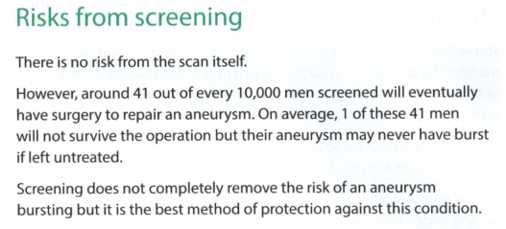The invitation came with a booklet helpfully explaining what ultrasound scans of the aorta are all about. It seems that men (which for the purposes of life-saving screening programmes also includes those trans women who wish to participate) have a much higher chance of having an aortic aneurysm than do women. Here are the cheerful stats from the booklet:

A healthy aorta has a diameter of between 1.4cm and 2.4cm; mine came smack in the middle at 1.9cm. I shan't be dying of an aortic aneurysm, then. About 1 in 1,000 men have an aorta wider than 5.5cm, though, and these are the ones the programme hopes to pick up. 5.5cm is over 2 inches, which isn't quite as wide as a drainpipe but it's close; I don't know how there's room inside anyone for an aorta that large, but apparently there is.
85% of people who have an aortic aneurysm died of it on the spot. One of my university colleagues got one but was in the 15% who survived, thanks to the quick-thinking of another colleague who was with him when it happened. He hadn't had a scan because he was under 64, so didn't find out about his problem in time for a preventative operation.
The woman who did the ultrasound only does aortas. She prefers them because, unlike a foetus, aortas don't move around. Occasionally, she has to do aorta scans of young children, who universally hate it for reasons no-one seems to know. I enquired of her whether people often asked if their aorta was male or female. She said yes, they do.
1.9cm is like the width of a thumb. I hope that's big enough to supply sufficient blood to my extemities to keep them going as I get older.